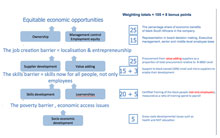
The revised codes are difficult, but what are they trying to achieve?
This article revisits the original intention of B-BBEE and describes how the changes in the RCoGP support the emergent transformation needs of South Africa today.
Restating the original intent
The original objectives of B-BBEE, as stated by the Department of Trade and Industry (dti) Strategy Document (2003) were to create "an integrated and inherent socio-economic process, that directly contributes to the transformation of South Africa and brings about significant increases in the number of black people that manage, own and control the country's economy, as well as significant decreases in inequalities."1
This was formed from the late 1990s to 2003, while the country, at a socio-political level, was driven by a neoliberal model. There was an understanding that BBBEE was predominantly focused on building and strengthening a middle class, rather than being a grass-roots poverty alleviation and access mechanism. This can be seen in the relatively low weighting given to socio-economic development.
It was tacitly understood that business would focus on the barriers to entry for those economic factors that were about to become active, thus stimulating quick growth and increasing the tax base, which the government could then use to enable those participants that were further away (in time and capacity) from becoming economically active.
Times and circumstances change and the Codes of Good Practice (CoGP) now have a built-in process for updating best practice every five years to ensure a good fit with the emergent current reality.
Reviewing the original intent
While we have seen some significant development of a black middle class, the country has clearly emerged over the years since 2003 with fresh challenges. These can be best understood and seen through the lens of the nine critical success factors detailed in the National Development Plan (2011) (National Development Plan Vision 2030 -lo-res.pdf Download)
- Too few people work
- Poor Education
- Infrastructure is under maintained and insufficient
- Spatial patterns drive inequality
- Economy is overly resource intensive
- Failing public health system
- Corruption
- Poor public services
- Divided society
View the National Planning Commission Youtube channel for the NDP rationale.
After reviewing behaviour against the first five-year round of the CoGP, as well as taking global best practice into account, such as Malaysia's experiences in the 80s (BBBEE a 5 year review), it was felt that the following principle changes were needed in the CoGP as encapsulated in the model below:
The diagram above refers to five key principle changes reflected in the revised CoGP that need to be resolved in the right sequence as follows:
- We need to re-channel the focus on SED out of education (which will be captured in skills development) and into other barriers to economic access, such as heath, poverty alleviation and basic service delivery.
- We need to refocus our skills efforts to include non-employees, such that our future skills pool is developed and equipped to become employed. We need to ensure that our learnership and artisanship processes are effectively used as work preparation and employee courtship processes, so that there is effective retention of our unemployed learners.
- We need to ensure that access to economic opportunity for small black-owned businesses is enhanced through supplier development. This will benefit both entrepreneurs and the jobs that are stimulated through this process. Malaysia utilised this to overcome the "twin economies" behaviour evident in their economy at the time. In South Africa the same concept could apply, namely bringing established business and small informal business into supply partnerships to stimulate growth and competitiveness and mutual benefit. This manifests as a black ownership, small business focus in this pillar, as 95% of businesses in the country are small enterprises with the bulk of these being black-owned.
- We need to ensure, as far as is economically viable, that our supply chains are localised, to enhance value added supply and job creation.
- We need to ensure that ownership (through broad-based, employee ownership or strategic partners) exceeds the unencumbered subminimum of 10%.
Conclusion
In an environment where we have a worsening state of inequality, it is vital for the country to revise its efforts and focus wholeheartedly on promoting social inclusivity, in an attempt to deal effectively with varying expectations in South Africa.
However, it is when we translate this national compact into a business context that difficulties emerge. We need to simultaneously promote and stimulate economic growth and at the same time promote inclusivity if we are to emerge as a country that effectively serves all its citizens. The RCoGP require a fundamental strategic review in order to align itself with both national and business objectives. Invasive surgery is never easy, but it is sometimes necessary




















